8/25/2011
Northern (High)lights
Jennifer Zurko
It’s been a few years since
GrowerTalks headed north of the border—12 years to be exact—so it was about time we grabbed the passport to visit this horticulture hotbed.
The Ontario region of Canada (we were in the Toronto/Niagara areas) is indeed one of the largest producers of ornamentals, cut flowers and pot plants. According to Wayne Brown of the Ontario Ministry of Agriculture, Food & Rural Affairs (OMAFRA) and the Vineland Research & Innovation Centre, the greenhouse industry has seen significant growth during the last 25 years.
Until 2004, expansion by more than 10% occurred each year even through times of Canadian economic recession. And the 2009 report from Statistics Canada stated the farm gate value of the Ontario greenhouse floriculture industry was $742 million, which was a 21% increase over 2008, putting it behind California and Florida as the third largest producer of floriculture products in North America. Nestled comfortably between Michigan and New York, the effects of Lake Ontario and Lake Erie help keep the climate within Zones 5-6.
However, these growers and retailers have their share of challenges. Export sales are vital to many of the wholesalers in the area with some of their biggest customers residing in the U.S., but the rise of the Canadian dollar, growing transportation costs and stricter border security (especially since 9/11) have caused a rapid decrease in overall exported products. Sales to the U.S. have declined 45% since 2003, but have shown a slight increase during the last two years.
Also, the ban of a significant number of certain pesticides in Canada has forced most growers to adopt new measures of biological pest control and prevention. While this has been positive for the industry, it still brings a level of frustration.
We stopped by a few of the key players around the St. Catharines area of Ontario to see how they were tackling these challenges and to find out how their spring was panning out.
Fi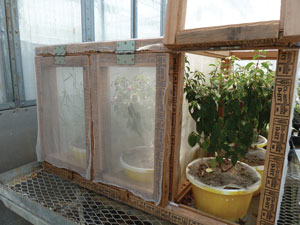 ghting mites with might
ghting mites with might
Head grower and
GrowerTalks columnist Albert Grimm has worked for Jeffery’s Greenhouses in St. Catharines for the last 13 years. Strictly a wholesale grower for Home Depot, Albert says they grow more than 120 genera of bedding plants under 20 acres and about 90% of their inventory is planned well in advance. Of course, there are always the last-minute orders, but they strive to maintain a flexible nature that allows them to fulfill every request.
pictured: Jeffery’s homemade parasitoid wasp houses help to “train” them to recognize the scent of an aphid so the wasps know what to attack when they’re released into the greenhouse.
“In a sense, growing for a big box store isn’t any different from picking your own varieties,” Albert explains. “The challenge is that a lot of the product is brand new and not necessarily tested for a long period of time. But we have the flexibility to adjust.”
The need for flexibility makes it difficult to automate production. Much of their handling, layout and watering is done manually, but the money some people spend on new machinery, Jeffery’s spends on planning and details. “We don’t have a lot of fancy equipment, but we have fancy ways of doing things,” said Albert—including how they manage greenhouse pests.
Now run by the fourth generation of the Jeffery family, this operation (with two locations) is extremely proud of the strides it has made with biological pest controls. In a competitive industry, many of the local growers found themselves sharing ideas on how to battle insects “out of desperation” because of the pesticide bans, said Albert. “We couldn’t be at the level we’re at without the other local greenhouses working together.” And it’s a constant struggle. During our visit Albert explained that he currently does not have a means of controlling thrips or whiteflies with pesticides, and that the resistance problem with aphids was starting to get worse.
But Albert is familiar with the world of biologicals. He’s been working with them since 1983 and has developed his own parasitoid wasp “breeding program.” With the help of Dr. Graeme Murphy of OMAFRA, Albert built a mesh structure that houses the wasps in the greenhouse. The idea is to “train” them to get used to the smell of the aphids in the greenhouse since parasitoids attack based on scent. It’s helped to keep the aphid population down just in time for summer transplanting and cyclamen germination.
In with the new
When we walked into Creekside Greenhouses in the town of Jordan Station, we immediately noticed that new greenhouse “smell,” and we were right. Owner Arie Koole had recently replaced almost all of the old glass structures that dated back to the 1950s and ’60s when his father Marinus started the business. Arie said cost definitely went into the decision to go with plastic for the new houses, but they’re also more energy efficient than glass. “I saved more on heat than I spend on interest,” Arie said about the old houses. Creekside has a total of 7 acres of greenhouse.
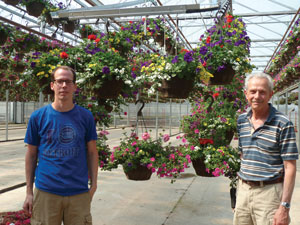 pictured: Arie Koole (right) and his son Matt own Creekside Greenhouses, which has recently renovated almost all of their old facilities to include new automation like the Formflex hanging basket system.
pictured: Arie Koole (right) and his son Matt own Creekside Greenhouses, which has recently renovated almost all of their old facilities to include new automation like the Formflex hanging basket system.
Arie put in ebb-and-flood floors in the new 35,000 sq. ft. peak vent house, and it’s proved to be an ideal investment. Arie explained that the flood floors make it easier for them to plant, switch out crops and ship. Plus, it’s better for larger containers.
The greenhouse was bustling with activity as workers were busy moving product around, shipping the summer crops to make room for mums, poinsettias, Easter lilies and hydrangeas—which they were growing under plastic cover in the new double-shaded peak vent house. Arie grows most of his hydrangeas and mums on 12 acres of outdoor production, especially since hydrangeas are so difficult to grow. They set bud outdoors and are then brought inside and gassed so they defoliate, then grown cool for eight weeks, which is why it takes a year to finish.
And where does all of this product go? Creekside’s primary customer is Costco and everything is pre-sold, said Arie. The business began as a fruit farm, but quickly changed over to bedding plants and now they grow everything from annuals to woody ornamentals.
Luckily, Arie doesn’t have to handle it all himself; his sons Matt and Brandon left the world of economics to join the family business. When asked which was the more stressful industry, Matt said the greenhouse business is definitely the one that will keep you on your toes.
Keeping it simple
Twenty-three years ago, Andy and Brenda Fluit started with two hoop houses filled with grafted grapevines for the local wineries. Now, Sunshine Express includes 5 acres of a successful retail garden center in Niagara-on-the-Lake and 10 acres of bedding plant production just down the street. The proximity helps to keep the flow of product going through the garden center so there’s never any empty spots and the customers get what they’re looking for.
The only crops Sunshine Express doesn’t grow is nursery stock; the rest of the pie (which is about 95%) is grown on-site specifically for the garden center. Andy said they don’t do wholesale growing, which allows them to really keep track of consumer trends. It’s easy when you know which type of customer is shopping when. Andy said different people shop at different times. He breaks down his consumers like this: “early shoppers” come in the first days of (barely) spring because they’re worried there won’t be any plants left; the “middle shoppers” come in after the first frost-free date because that’s the time to buy; and the “last shoppers” tend to come in late because they’re more careful buyers, especially if the weather is bad.
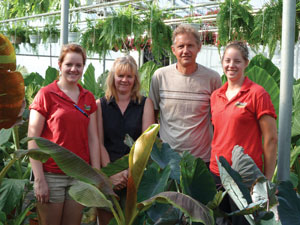 pictured: Brenda and Andy Fluit (middle), owners of Sunshine Express Garden Centre, started the business with two hoop houses. Now their daughters Sabrina (left) and Tanya are helping with their biological control program.
pictured: Brenda and Andy Fluit (middle), owners of Sunshine Express Garden Centre, started the business with two hoop houses. Now their daughters Sabrina (left) and Tanya are helping with their biological control program.
One thing you won’t find at Sunshine Express Garden Centre—hardgoods. Andy sells soil, but got out of offering pottery and other hardgoods after realizing he could sell 10-15 hanging baskets versus a couple of terra cotta pots in the same space. “We’re here to sell plants,” said Andy, so he keeps his business model simple.
Sunshine Express’ specialties are hanging baskets and planters, but they also have a large herb program with special tags Andy created to help customers identify the plants according to use. He said they do a lot of 6-in. production, which they’ve always done, but “the trend is going toward bigger containers,” said Andy.
And just like many other growers in the area, Andy continues to use biological pest control. His two young daughters are just finishing college and are now working for the business, conducting different biocontrol trials. “[Biocontrols] cost you money, but what would you rather have? It’s all gotta be good or we’re eating it,” explained Andy.
Oldie, but goodie
One of the most established businesses in the Niagara area, Lou Schenck’s great-grandfather bought property near the Welland Canal in 1885, when he started growing vegetables and opened a cannery. The current location of Schenck Farms in St. Catharines was purchased in 1907 on 8 ft. of sand that use to be the bottom of part of Lake Ontario. Lou’s great-grandfather immediately built a greenhouse for veggie transplants. By the 1950s, the cannery was becoming too much of a headache, so Lou’s grandfather sold it when he joined the business. His main goal was to grow flowers, so he added bedding plants to the farm.
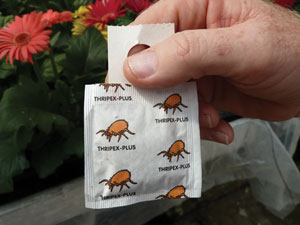 pictured: Schenck Farms uses biological controls like these bran mite sachets that hang on their gerbera plants to control pests.
pictured: Schenck Farms uses biological controls like these bran mite sachets that hang on their gerbera plants to control pests.
Since then, Schenck Farms—now run by Lou, his two brothers and cousins, who are the fourth generation—has grown a variety of different crops, from bedding to potted plants. More than 100 of their 200 acres is being used for production, including outdoor farming of peaches and grapes to compete with the U.S. product. Ninety percent of their young plants is for growers in Canada and 80% of their potted plants are exported to chain stores in the States. Lou also sells to independent garden centers and contract grows for the U.S. and Canada. And because the temperature rarely goes below 0F (thanks to the lake effect), they also grow grapes for the local wineries. Being on the same latitude as Bordeaux, France, helps them provide good varieties for Cabernets, Rieslings and Chardonnays.
Growing and selling to all of these markets keeps them busy. “We’re competent at it,” said Lou. “But each segment gets more difficult.” Thankfully, Lou says they got out of growing strawberries, which he says he doesn’t miss. “If you think the greenhouse industry is tough, try fresh fruit.”
Dealing with Canadian pesticide bans adds interesting problems to the mix. Three years ago, their ivy geranium crop was being wiped out by Western flower thrips. Lou tried different sprays, but couldn’t completely control the problem, so they took a multi-pronged approach with biocontrols to get rid of the problem—working with the biocontrol suppliers, sticking to a strict schedule, and being more disciplined. Dr. Murphy from OMAFRA helped Lou nail down a program, refined their scouting methods with sticky cards, and now he’s able to control most of their pest issues before they become disasters. And he doesn’t have a problem sharing his success stories with other
growers.
“We’ve been able to produce a Western flower thrips-free mum and gerbera for a few years now,” said Lou. “There’s no need to compete when it comes to bios; nothing is proprietary.”
Using biocontrols is more costly than pesticides, but if there are limited options, you have to do what’s best for your crop. To control costs, Lou uses banker plants like eggplant—20 plants can handle 10,000 sq. ft. of greenhouse.
Lou estimates he spends 10 cents per pot for 4- and 6-in. gerberas on biocontrols. However, “in the long term, I fully expect to get the cost down and be successful at it,” said Lou. “Pretty soon, bios will be the only option.”
First class experience
When it comes to marketing their brand, TERRA has worked hard to develop a strong campaign that keeps all four of their locations at peak performance. We visited the original location in Waterdown, which was renovated five years ago and totals 1 acre of retail and 5 acres of production. Jim and Margaret Pepetone along with their three sons, Andrew, Chris and Clinton, own the business. Three of the four locations are open year round and not only do they grow and sell plants, but customers also can buy outdoor furniture, garden accessories, giftware—everything that provides the customer with the ultimate experience, said Bill Bown, TERRA’s senior manager of marketing.
And that includes details some may consider minute, but are vital to TERRA’s business. One of the things they did was to remove the word “greenhouses” from their logo. They found that people, especially the younger demographic, associate that word with wet, dirty floors. “We wanted to create an environment where women could wear pumps in our store,” said Bill, so the staff is diligent about keeping the concrete floors free of water and debris, even after the busy weekends. The store should look the same Monday morning as it does on Saturday because “every seat is first class,” stated Bill.
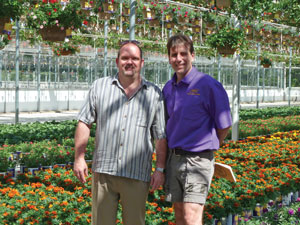 pictured: TERRA’s senior manager of marketing Bill Bown (left) and senior production manager Chris Pepetone have worked hard to re-invent their brand to be more modern and service oriented.
pictured: TERRA’s senior manager of marketing Bill Bown (left) and senior production manager Chris Pepetone have worked hard to re-invent their brand to be more modern and service oriented.
Also, they changed their ambience—background music, scent machines, signage, even the uniforms the staff wears are now part of the company’s overall service model, which Bill says is no different from other retailers. The hard part is keeping up with the trends, so the Pepetones have created a strong merchandising team to keep the store looking fresh. The plants are what bring the people in; the displays make them slow down when they come in on a mission, said Bill.
A comprehensive advertising campaign with radio and TV ads, along with their weekly “TERRA @ Home” TV show and large in-store events—like “Boxing Day in May,” which had 1,200 people waiting outside for the doors to open at 6 a.m.—keeps their brand in the forefront of their customers’ minds and entices new ones to visit.
GT